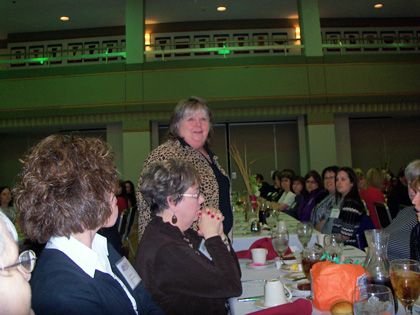Kansas Reading Association President Donita Shaw shared the council's many activities—local to international—with Reading Today.
What are some exciting upcoming council projects?
At a state level, Kansas Reading Association has actually just finished several projects. The governor proclaimed January as Kansas READ month and we provided activities to promote literacy. We have a picture book award in honor of Bill Martin Jr., and members just voted for this year’s winner. We also have a newly designed website. Our 2012 journal will be forthcoming. Our future goals are to continue building on the work we’ve done during 2012-2013 with sponsoring service projects, providing professional development at our fall conference in Wichita October 13-14, 2013, and supporting local councils. Our local councils will hold their spring meetings in March and April. Some will focus on author visits, a spring tea, Dr. Seuss, and e-readers such as Nook, Kindle, and iPads.
What types of literacy outreach do your state and local councils do?
One of KRA's goals is to support an international literacy project, Ethiopia Reads, led by LeAnn Clark. Lives are being changed! This year our feature is Bring a Book Buy a Book (BABBAB). It is a program that any school can do—kids "run it." Children bring gently used books and donate one, and then buy one for a low price. The proceeds go to purchase books for Ethiopia- it even gives them the chance to support the book publishers in Africa and then we don't have to pay the shipping. See http://www.ethiopiareads.org.
Local councils are very involved in their communities. For example, magazines are provided for children who stay at Hope House, books are provided to parents of young children, thesauruses are given to foreign exchange students, book writing contests are held, scholarships are given, and many other contributions have and will continue to be made.
What are the benefits of joining your council?
There are many, many benefits of joining the Kansas Reading Association (KRA).
- KRA has become a strong voice and respected resource in Kansas Learning First Alliance.
- KRA strives to engage in a collaborative relationship with KSDE and be a natural advocate for all KRA is doing for the teaching of literacy.
- KRA is working to raise awareness of our organization and literacy issues among administrators.
- KRA is providing important professional development opportunities for teachers (preservice and inservice teachers too) through local councils and an annual fall conference.
- KRA is providing important professional development opportunities for teachers through the publication of Kansas Journal of Reading which is published annually. This is a premier resource for instructional strategies and discussion of research.
- KRA is providing community service through local and state programs.
- KRA provides leadership training that members can use in their local councils as well as their schools and communities.
- KRA offers the opportunity to associate with good, hardworking, earnest, dedicated professionals.
- KRA encourages literacy through its professional and volunteer awards to those individuals and businesses helping to promote literacy.
- KRA encourages literacy through its grants to councils that promote literacy projects.
How does one join or become involved?
To join, a prospective member may visit our website at www.kansasread.org. Click on the tab “join KRA” and the requested information will be provided there. To be involved please feel free to find a local council (tab on the left of the website) and contact the leaders. The Kansas Reading Association Executive Board is always happy to assist you in finding ways to be involved.
Is there anything else you'd like to share about your council?
We are so proud of Babs Tims, a veteran fourth grade teacher at Lakeside Elementary School in Pittsburg, KS! Babs was honored at the 2012 IRA Annual Convention as “Celebrated Teacher of the Year.” Thank you Babs, for inspiring young readers!
Our 2012-2013 year has been a year of growing visibly within our organization as well as in our communities. We are committed to serving our constituency by “promoting quality literacy experiences for all.”

"Celebrated Teacher of the Year" Babs Tims, a veteran fourth grade teacher at Lakeside Elementary School in Pittsburg, KS.